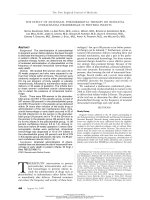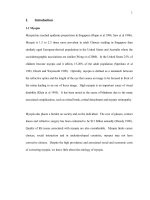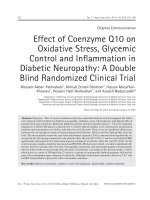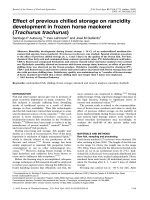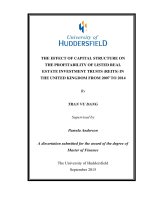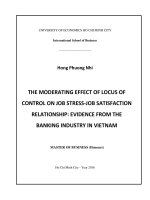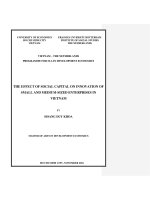Effect of wastewaters on concentration of micronutrients in dominant soils of north Karnataka, India
Bạn đang xem bản rút gọn của tài liệu. Xem và tải ngay bản đầy đủ của tài liệu tại đây (358.23 KB, 11 trang )
Int.J.Curr.Microbiol.App.Sci (2019) 8(4): 1059-1069
International Journal of Current Microbiology and Applied Sciences
ISSN: 2319-7706 Volume 8 Number 04 (2019)
Journal homepage:
Original Research Article
/>
Effect of Wastewaters on Concentration of Micronutrients
in Dominant Soils of North Karnataka, India
Hanamantarao Jogan* and G.S. Dasog
Department of Soil Science and Agricultural Chemistry, UAS, Dharwad – 580 005, India
*Corresponding author
ABSTRACT
Keywords
Wastewater, Water
quality, Lateritic,
Red and black soil
Article Info
Accepted:
10 March 2019
Available Online:
10 April 2019
Water scarcity and increase wastewater generation are twin problem associated which
needs to be addressed to derive benefit for agricultural production. In this context
laboratory study was conducted to characterize the wastewater from four different sources
(Ugar sugar-Ugar khurd, West coast paper mill-Dandeli, Nectar beverages-Dharwad,
Domestic sewage water-UAS campus Dharwad) in north Karnataka and were compared
with freshwater. Spentwash from the Ugar Sugar Works distillery was singularly different
from rest of the wastewaters and was characterized by its high pH, EC, TSS, TDS, BOD,
COD, total nitrogen, phosphate, potassium and sulphate concentration. The effect of the
wastewaters on the dominant soils of north Karnataka (Red, Lateritic and Black soil) were
evaluated in column study during March-2014 to April-2015. Wide variation in water
characteristics was recorded with wastewaters studied. Application of 8 pore volumes of
different wastewaters increased Fe, Cu, Mn, Zn and B of the soils over freshwater
application. Among the wastewaters, biomethanated spentwash induced greater influence
on the recorded soil parameters. Higher values of the observed soil parameter were
recorded in the surface soil (0-15 cm) in comparison to other depths (15-30 cm, 30-45 cm
and 45- 60 cm).
Introduction
Increasing scarcity of water has turned to be
regular phenomenon in the recent past.
Priorities of the water use have also being
changing with increased demand from the
other sectors creating competition for the
water use in agriculture sector. Rapid
population increase in urban areas and
industrialization gives rise to concern about
appropriate water management practices.
Surface waters are being polluted by means of
wastes or effluent discharge from the
industries, domestic sewage, and municipal
wastes etc. Further land application of
wastewater is now becoming one of the most
economically and ecologically viable method
of disposal of these waters. With rapid
expansion of cities and domestic water
supply, quantity of grey/wastewater is
increasing in the same proportion. Overall
analysis of water resources indicates that in
coming years, there will be a twin edged
problem to deal with reduced fresh water
1059
Int.J.Curr.Microbiol.App.Sci (2019) 8(4): 1059-1069
availability and increased wastewater
generation. Non-conventional water resources
play greater role for water augmentation to
achieve food security in water-scarce
countries in the near future. Urban agriculture
using wastewater provides food, income and
employment to thousands of people.
Nevertheless,
reusing
wastewater
in
agriculture is considered a deleterious practice
since it may introduce pollutants to the
environment, spread waterborne diseases,
chemical contamination, soil salinization and
contamination of groundwater sources,
generate odour problems and result in
aversion to the crops (IWMI, 2006).
Contrarily, this kind of reuse may result in
some benefits for soils, crops and farmers.
Nowadays, the reuse of wastewater in
agriculture is seen in some countries as a
convenient environmental strategy. Globally
around 3 to 3.5 million hectares are irrigated
with raw and diluted wastewater irrigation.
Wastewater is therefore, considered an
appropriate option for reuse. Wastewater
contains a significant load of biodegradable
organic material and nutrients which are
necessary for the growth of crops.
Accumulation of organic matter in soil by
irrigation with wastewater can be beneficial
as it may result in the enhancement of
physical structure of the soil, the increase in
soil microbial activity and improvement of
soil performance as a filter and degrading
media for pollutants.
The consistent use of wastewater in irrigation
may stabilize the content of nutrients in the
soil, even when growing crops with high
nutritional requirements; this is because the
continuous withdrawal of nutrients by plants
is compensated by the constant input of
organic and mineral components into the soil
via wastewater. Effect of sewage wastewater
on black soil (Varkey et al., 2015), paper mill
wastewater on red soil (Sharma et al., 2014)
and spentwash on black soil (Singh and
Swami, 2014) have been studied. Composite
study on characterization of the wastewater
and their effect of different wastewaters on a
wide range of soil is sparse. Information on
effect of wastewater on a wide range of
dominant soils of north Karnataka under
controlled laboratory condition would give an
insight into their capacity to bear the load of
different chemical constituents. Thus a
comprehensive study on the effect of different
wastewaters characterized by different
properties on different soil types was planned
and executed under laboratory conditions.
Materials and Methods
The investigation was carried out by using
three dominant soils of north Karnataka viz.,
Red (Ustropepts), Lateritic (Kanhaplic
Haplustalfs), and Black soils (Typic
Haplusterts). Four different water sources
employed were domestic sewage, paper mill
wastewater, soft drink factory wastewater,
distillery spentwash and compared with fresh
water (borewell water).
The wastewater samples were collected from
different sources was used for the column
study. For the column study 5 cm diameter
PVC pipes of 60 cm long with perforated
bottom end caps were used. Initially the BD
of each soil sample was measured, based on
the BD and pipe column parameters (length
and diameter) the quantity of soil filled in the
each soil column was calculated.
Volume of pipe column = π r2 h, r = 2.5 cm,
h= 60 cm,
Volume of pipe column = 1178.25 cm3,
Weight of soil in column = Volume × BD
Each soil samples were properly processed
and passed through 2 mm sieve, before filling
the columns. Amount water added in each
column was based on maximum water
holding capacity of different soils. Irrigation
1060
Int.J.Curr.Microbiol.App.Sci (2019) 8(4): 1059-1069
was given in terms of pore volumes, totally 8
pore volumes were passed through soil
columns at an interval of 10 days. After
Soils
BD (g cm-3)
Red
Lateritic
Black
1.45
1.52
1.34
passing two pore volumes one set of column
was horizontally sectioned at an interval of 15
cm.
Quantity
of
soil
added
(kg)
1.71
1.80
1.57
Experiment was conducted using two factorial
CRD with three replication. Factor I included
different wastewater sources (1. Domestic
sewage water- UAS Dharwad, 2. Soft drink
factory treated wastewater- Nectar beverages,
Dharwad, 3. Paper mill treated wastewaterWest Coast Paper mill Dandeli, 4. Distillery
biomethanated spentwash (diluted with
normal water in the ratio of 1:3) - Ugar sugar
works Ugar khurd and 5. Normal water- Fresh
borewell water UAS Dharwad) and factor II
comprised of different soil depths (0-15cm,
15-30cm, 30-45cm and 45-60cm).
The pH and EC of the waters were analyzed
immediately after bringing the samples using
pH meter and Systronics direct digital
conductivity meter–304, respectively as
described by Tandon (1998). The dissolved
solids in the effluents were determined by
gravimetric method. The suspended solids in
the effluents were determined by filtration
method (Tandon, 1998).
The Biological oxygen demand (BOD) of
effluents were determined by measuring the
dissolved oxygen of the samples before and
after incubation at 200C for five days by
titrating it against sodium thiosulphate using
starch indicator and the BOD of sewage water
was calculated as described by Tandon
(1998). The Chemical oxygen demand (COD)
of wastewater was determined by open reflux
method. The total nitrogen in water samples
was determined titrimetrically after distilling
MWHC (%)
48.5
50.5
67
Amount of water added
per one pore volume
(ml)
828
903
1057
the NH3 in boric acid mixed indicator. The
phosphates in the effluents were determined
by chloro-stannous reduced blue colour
method. Potassium in the effluents was
determined by using the flame photometer
with suitable dilutions as described by
Tandon (1998).
The pH of soil was determined in 1: 2.5 soils
to water suspension after stirring the samples
intermittently for half an hour using a
Systronics direct digital 331 pH meter.
Electrical conductivity of the soil was
determined in the supernatant of 1:2.5 soils to
water suspension by using Systronics direct
digital conductivity meter–304 (Sparks et al.,
1996). The organic carbon content was
determined by taking finely ground sample by
wet oxidation method as described by Jackson
(1967). The available boron in soil was
extracted by hot water (Hesse, 2002) and the
extracted boron was then treated with
curcumin-oxalic acid reagent and the intensity
of color developed was measured by
spectrophotometer at 540 nm. Micronutrients
in the soil samples were extracted by using
DTPA extractant and the content of Fe, Zn,
Cu and Mn were measured by atomic
absorption spectrophotometer (Lindsay and
Norvell, 1978). The experimental data was
statistically analyzed as per Gomez and
Gomez (1984) for soil chemical properties.
The computed data was interpreted with a
critical differences level at 1 per cent.
1061
Int.J.Curr.Microbiol.App.Sci (2019) 8(4): 1059-1069
Results and Discussion
The pH of sewage water and the wastewater
from paper mill were near neutral whereas
those from soft drink factory and distillery
biomethanated spentwash were alkaline. The
EC of paper mill and soft drink factory
wastewaters were around 2 dS m-1 whereas
the sewage water was 1.23 dS m-1 closely
followed by the normal water of the campus.
The spentwash from the Ugar Sugar Works
distillery was the most saline with an EC of
11.54 dS m-1 and in many other properties
such as TDS, TSS, BOD, COD, Total N, P
and K contents was singularly different from
rest of the wastewaters (Table 1).
With respect to total N, P and K, the
remaining three wastewaters had similar
content. The sewage water was characterized
by its high TSS, TDS, BOD and COD, the
values of which were much less in soft drink
factory wastewater and paper mill wastewater
except for high TDS and COD (Table 2).
Table.1 Initial properties of soils studied
Properties
pH (1:2.5)
EC (dS m-1)
OC (g kg-1)
Available Boron (mg kg-1)
Available Copper (mg kg-1)
Available Zinc (mg kg-1)
Available Iron (mg kg-1)
Available Manganese (mg kg-1)
Red soil
Lateritic soil
Black soil
6.15
0.14
8.0
0.88
4.77
1.01
33.2
59.6
5.60
0.28
4.6
0.47
0.36
0.23
10.3
19.0
7.10
0.21
4.7
0.48
1.31
0.39
10.5
23.4
Table.2 Chemical composition of water samples
Parameters
pH
EC (dS/m)
TSS (mg L-1)
TDS (mg L-1)
BOD (mg L-1)
COD (mg L-1)
Ca+ Mg ( meq L-1)
Sodium (meq L-1)
Total-N (mg L-1)
Total-P (mg L-1)
Total –K (meq L-1 )
NO3-N (mg L-1)
Sulphate (mg L-1)
Sewage
7.33
1.23
480
662
256
410
8.6
6.30
23.7
13.45
0.74
1.69
7.22
Soft drink
factory
8.14
2.09
18
30
8.29
27
4.8
6.86
20.57
8.25
0.72
1.45
7.87
1062
Paper mill
Spentwash
7.4
1.85
36
748
21
158
5.6
7.08
25.4
10.34
1.35
1.78
8.13
8.3
11.54
1115
1975
1800
4508
13
8.69
130.4
28
39
2.85
9.25
Normal
water
6.91
0.72
8
12
9
14
4.0
3.26
1.25
0.10
0.20
0.75
2.5
Int.J.Curr.Microbiol.App.Sci (2019) 8(4): 1059-1069
Table.3 Available boron (mg kg-1) in red and lateritic soils after passing different pore volumes of various wastewaters
D1
Red soil
8 pore volumes
D2
D3
D4
M
D1
Lateritic soil
8 pore volumes
D2
D3
D4
W1
2.40
1.30
1.10
1.00
1.45
0.91
0.85
0.76
W2
1.80
1.30
1.20
1.00
1.33
0.82
0.66
W3
1.95
1.40
1.40
1.20
1.49
0.86
W4
2.90
1.50
1.40
1.30
1.78
W5
1.20
1.00
0.70
0.70
Mean
2.05
1.30
1.16
1.04
W/S
W
M
D1
Black soil
8 pore volumes
D2
D3
D4
0.65
0.79
1.30
1.21
1.00
0.92
1.11
0.59
0.53
0.65
1.22
1.08
0.92
0.84
1.02
0.72
0.65
0.57
0.70
1.25
1.13
0.95
0.86
1.05
1.53
1.21
0.94
0.83
1.13
1.63
1.33
1.25
1.19
1.35
0.90
0.62
0.52
0.42
0.33
0.47
0.63
0.53
0.43
0.32
0.48
1.39
0.95
0.79
0.67
0.58
0.75
1.21
1.06
0.91
0.83
1.00
S.Em±
CD at 1%
S.Em±
CD at 1%
S.Em±
CD at 1%
0.008
0.03
0.006
0.02
0.009
0.03
D
0.008
0.03
0.005
0.02
0.008
0.03
WxD
0.017
0.06
0.012
0.05
0.017
0.07
W1- Sewage water
D1= 0 to 15 cm depth
mean of triplicates)
W2- Soft drink factory wastewater
D2= 15 to 30 cm depth
W3- paper mill wastewater
D3= 30 to 45 cm depth
1063
W4-distillery spentwash
D4= 45 to 60 cm depth
W5- normal tap water
M – Mean (each values
M
Int.J.Curr.Microbiol.App.Sci (2019) 8(4): 1059-1069
Table.4 Cu (mg kg-1) status in red, lateritic and black soils after passing 8 pore volumes of wastewaters
W1
Red soil
8 pore volumes
D1
D4
5.98
5.04
M
5.51
D1
0.77
W2
5.36
4.86
5.11
0.78
W3
5.27
4.73
5.00
W4
7.44
6.77
W5
4.92
Mean
5.80
W/S
W
Lateritic soil
8 pore volumes
D4
0.52
M
0.65
D1
2.50
Black soil
8 pore volumes
D4
2.35
0.55
0.67
2.57
2.34
2.46
0.80
0.57
0.69
2.60
2.36
2.48
7.10
1.05
0.73
0.89
4.34
3.18
3.76
4.62
4.77
0.37
0.34
0.36
1.38
1.23
1.31
5.20
5.50
0.75
0.54
0.65
2.68
2.29
2.49
M
2.43
S.Em±
CD at 1%
S.Em±
CD at 1%
S.Em±
CD at 1%
0.014
0.06
0.003
0.01
0.010
0.04
D
0.013
0.05
0.003
0.01
0.009
0.03
WxD
0.029
0.11
0.006
0.02
0.020
0.08
W1- Sewage water
D1= 0 to 15 cm depth
mean of triplicates)
W2- Soft drink factory wastewater
D2= 15 to 30 cm depth
W3- paper mill wastewater
D3= 30 to 45 cm depth
1064
W4-distillery spentwash
D4= 45 to 60 cm depth
W5- normal tap water
M – Mean (each values
Int.J.Curr.Microbiol.App.Sci (2019) 8(4): 1059-1069
Table.5 Zn (mg kg-1) status in red, lateritic and black soils after passing 8 pore volumes of wastewaters
W1
Red soil
8 pore volumes
D1
D4
2.13
1.92
M
2.03
D1
0.55
W2
2.07
1.84
1.95
0.93
W3
2.28
1.96
2.12
W4
5.30
3.07
W5
1.17
Mean
2.59
W/S
W
Lateritic soil
8 pore volumes
D4
0.30
M
0.43
D1
1.89
Black soil
8 pore volumes
D4
1.24
0.50
0.71
1.96
1.30
1.63
1.00
0.67
0.84
2.04
1.39
1.71
4.18
1.45
0.95
1.20
3.26
1.88
2.57
0.85
1.01
0.25
0.20
0.23
0.45
0.33
0.39
1.93
2.26
0.84
0.52
0.68
1.92
1.23
1.57
M
1.56
S.Em±
CD at 1%
S.Em±
CD at 1%
S.Em±
CD at 1%
0.030
0.12
0.008
0.03
0.019
0.07
D
0.027
0.10
0.007
0.03
0.017
0.06
WxD
0.061
0.23
0.016
0.06
0.038
0.14
W1- Sewage water
D1= 0 to 15 cm depth
triplicates)
W2- Soft drink factory wastewater
D2= 15 to 30 cm depth
W3- paper mill wastewater
D3= 30 to 45 cm depth
1065
W4-distillery spentwash
D4= 45 to 60 cm depth
W5- normal tap water
M – Mean (each values mean of
Int.J.Curr.Microbiol.App.Sci (2019) 8(4): 1059-1069
Table.6 Fe (mg kg-1) status in red, lateritic and black soils after passing 8 pore volumes of wastewaters
W1
Red soil
8 pore volumes
D1
D4
51.2
38.4
M
44.8
D1
13.4
W2
52.8
40.6
46.7
14.0
W3
51.4
38.8
45.1
W4
120.7
69.0
W5
34.2
Mean
62.1
W/S
W
Lateritic soil
8 pore volumes
D4
11.9
M
12.7
D1
16.9
Black soil
8 pore volumes
D4
14.1
12.6
13.3
17.7
15.3
16.5
13.7
12.2
12.9
17.0
14.4
15.7
94.8
18.9
16.7
17.8
35.2
25.2
30.2
32.2
33.2
10.8
9.8
10.3
11.3
9.8
10.5
43.8
52.9
14.2
12.6
13.4
19.6
15.8
17.7
M
15.5
S.Em±
CD at 1%
S.Em±
CD at 1%
S.Em±
CD at 1%
0.357
1.37
0.181
0.69
0.215
0.82
D
0.319
1.22
0.162
0.62
0.192
0.73
WxD
0.714
2.73
0.362
1.38
0.430
1.64
W1- Sewage water
D1= 0 to 15 cm depth
of triplicates)
W2- Soft drink factory wastewater
D2= 15 to 30 cm depth
W3- paper mill wastewater
D3= 30 to 45 cm depth
1066
W4-distillery spentwash
D4= 45 to 60 cm depth
W5- normal tap water
M – Mean (each values mean
Int.J.Curr.Microbiol.App.Sci (2019) 8(4): 1059-1069
Table.7 Mn (mg kg-1) status in red, lateritic and black soils after passing 8 pore volumes of wastewaters
W1
Red soil
8 pore volumes
D1
D4
73.7
69.3
M
71.5
D1
23.3
W2
74.3
70.2
72.2
24.7
W3
75.5
71.3
73.4
W4
283.7
152.3
W5
61.1
Mean
113.7
W/S
W
Lateritic soil
8 pore volumes
D4
21.5
M
22.4
D1
30.7
Black soil
8 pore volumes
D4
28.5
22.4
23.6
35.6
31.4
33.5
27.9
23.5
25.7
37.2
32.2
34.7
218.0
39.0
26.6
32.8
263.0
103.4
183.2
58.1
59.6
19.6
18.3
19.0
24.1
22.8
23.4
84.2
98.9
26.9
22.5
24.7
78.1
43.7
60.9
M
29.6
S.Em±
CD at 1%
S.Em±
CD at 1%
S.Em±
CD at 1%
0.397
1.52
0.168
0.64
0.378
1.44
D
0.355
1.36
0.151
0.58
0.338
1.29
WxD
0.795
3.04
0.337
1.29
0.755
2.89
W1- Sewage water
W2- Soft drink factory wastewater
normal tap water
D1= 0 to 15 cm depth
D2= 15 to 30 cm depth
Mean (each values mean of triplicates)
W3- paper mill wastewater
W4-distillery spentwash
W5-
D3= 30 to 45 cm depth
D4= 45 to 60 cm depth
M-
1067
Int.J.Curr.Microbiol.App.Sci (2019) 8(4): 1059-1069
Effect of different wastewater
concentration of micronutrients
on
Available micronutrient status (Fe, Cu, Mn,
Zn and B) of wastewater irrigated soils was
higher compared to normal water irrigated
soils due to addition of these micronutrients
and also organic matter through different
wastewaters (Table 3 to 7). Spentwash
exerted maximum influence in enhancing the
content of boron, zinc, iron, copper and
manganese as all of these are high in it
compared to other wastewaters. The boron
content was least in lateritic soil is perhaps
due to predominance of iron and aluminum
oxides in these soils, which are known to
adsorb boron. The higher boron content in red
soils is related to its initial high content even
with fresh water (Table 3). Sewage water
ranked next to spentwash in enhancing boron
content in all soils and copper content in red
soil (Tables 3 and 4). While soft drink factory
wastewater ranked next in respect of iron
content, paper mill wastewater ranked next in
respect of manganese content owing to their
high content in respective wastewaters next to
spentwash. Rattan et al., (2005) reported that
sewage irrigation for 20 years resulted in
significant buildup of DTPA extractable Zn,
Cu, and Fe in sewage water irrigated soils
compared to tube well water irrigated soils
(Table 4, 5 and 6). Vinod Kumar and Chopra
(2011) concluded that application of various
concentration of papermill effluent led to
significant increase in the micronutrient
concentrations in the soils. Singh and Swami
(2014) also reported increased concentration
of micronutrients in spentwash treated soils.
In conclusion, among the different treatments
W4 significantly increased the boron
concentration in soils under different pore
volumes application. The general sequence
followed was W4>W1>W3>W2>W5. The
effect of wastewaters was higher in red soil
followed by black soil and relatively less in
lateritic soil as judged by mean boron content.
The highest concentration of boron was
recorded at surface layer and steadily
decreased with the depth at all the pore
volumes in all the soils.
The DTPA extractable copper, zinc,
manganese and iron in the soils increased
from 4 to 8 pore volumes application of
various wastewaters and the content was
highest with W4. DTPA extractable zinc in
general was highest in red soil followed by
black soil. lateritic non- soil had less DTPA
extractable zinc. DTPA iron was appreciably
higher with W4 especially in red and black
soils. The DTPA extractable copper, zinc,
iron and manganese were more at the surface
(D1) than at D4 in all the soils.
References
Gomez, KA. and Gomez, AA. 1984.
Statistical Procedures for Agricultural
Research. John Willey and Sons, New
York (USA).
Hesse, R. 2002. A Textbook of soil chemical
analysis.
CBS
publishers
and
distributors, New Delhi.
IWMI. 2006. Recycling realities: Managing
health risk to make wastewater use an
asset. Water policy briefing, issue 17.
Jackson, ML. 1967. Soil Chemical Analysis.
Prentice Hall of India Private Ltd, New
Delhi.
Lindsay, WL. and Norwell, WA. 1978.
Development of DTPA soil test for
zinc, iron, manganese and copper. Soil
Sci. Soc. American J., 42: 421-428.
Ratna, PR. Jagdish Prasad and Joshi, AP.
2008. Changes in soil properties due to
irrigation
with
paper
industry
wastewater. J. Environ. Sci. Engg.,
50(4): 277-282.
Sharma, V. Umesh, KG. and Deepak Arora.
2014. Impact of pulp and paper mill
effluent on physico-chemical properties
1068
Int.J.Curr.Microbiol.App.Sci (2019) 8(4): 1059-1069
of soil. Arch. Appl. Sci. Res., 6 (2): 1217.
Singh, SV. and Swami, VK. 2014. Impact of
distillery wastewater irrigation on
chemical properties of agriculture soil.
Int. J. Innovative Res. Sci. Engg. Tech.,
3 (10): 17028-17032.
Sparks, DL. Page, AL. Helmake, PA. Loppert
RH. Soltanpour, PN. Tabatabai, MA.
Johnston, CT and Summer, ME. 1996.
Methods of Soil Analysis, Part 3, pp.
610-624.
Tandon, HLS. 1998. Methods of Analysis of
Soils, Plants, Water and Fertilizers.
Fert. Dev. and consultation Org., New
Delhi, India, pp. 9-16.
Varkey, BK. Dasog, GS. Wani, SP. Sahrawat,
KL. Hebbara, M. and Patil, CR. 2015.
Impact of long-term application of
domestic sewage water on soil
properties around Hubli city in
Karnataka, India. Agril. Res., 4(3): 272276.
Vinod Kumar and Chopra, AK. 2011.
Alterations
in
physico-chemical
characteristics of soil after irrigation
with Paper mill effluent. J. Chem.
Pharm. Res., 3(6): 7-22.
How to cite this article:
Hanamantarao Jogan and Dasog, G.S. 2019. Effect of Wastewaters on Concentration of
Micronutrients in Dominant Soils of North Karnataka, India. Int.J.Curr.Microbiol.App.Sci.
8(04): 1059-1069. doi: />
1069


